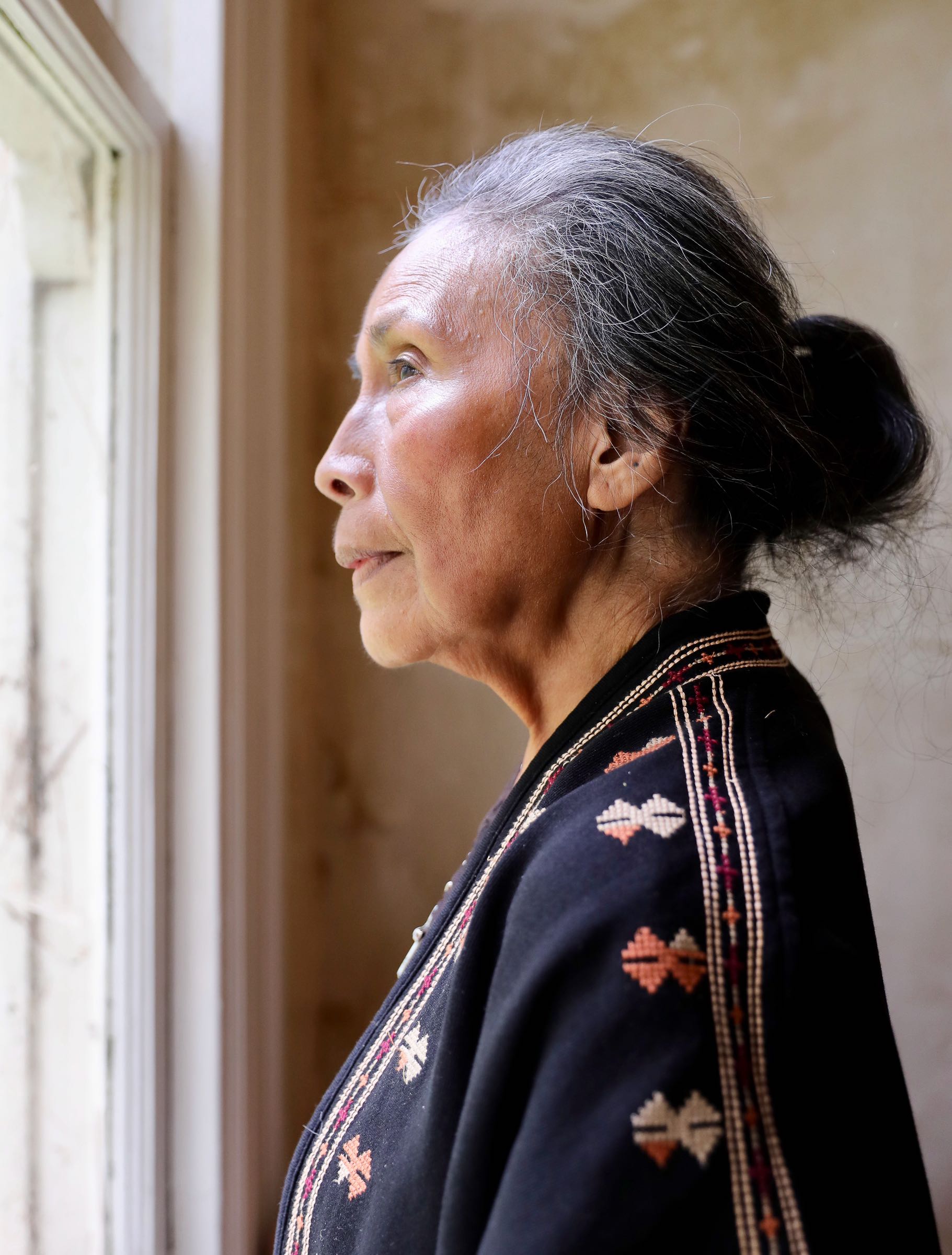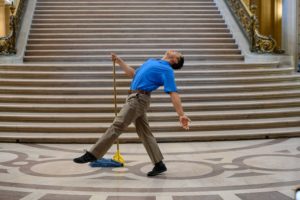
Panching Photo by Jessica Swanson. [ID: Panching, an elder Filipina, is in profile to the camera. She looks out a window of an historic house at Fort Barry with a contemplative look. She has brown skin and salt and pepper hair tied back in a low bun. She wears a navy blue print wrap.]
I was born in San Francisco. My gigantic Filipinx family geography triangulates The Bay, Wine Country, and the Central Valley. Ohlone, Miwok, Southern Pomo, and Yokut Lands. Site specifically, I am Golden Gate fog, I am oak savannah with the stench of Petaluma fertilizer season, I am crates of asparagus and bing cherries in the matter-of-fact heat of Stockton. My friends Damara and Patricia at the Joe Goode Performance Group have been dance-talking with me about belonging lately. How do we belong to the body? How does the body belong to a place?
My first show with Joe Goode was in 2004 – “Hometown.” While having my shy, young dancer body tossed around by fellow JGPG members Liz Burritt, Felipe Barrueto-Cabello, Marit Brooke-Kothlow and Rachael Lincoln, Joe drew me out of myself and into myself at the same time – as Joe Goode does. He choreographed a palm sweaty moment for me to crawl into the orchestra pit of YBCA, alone out there to sing a song with a picket fence encircling my ribcage. Singing is a root in my family culture – my father is a singer, his mother was a singer, her mother…Now at YBCA my Auntie Linda was sitting in the front row, 4 feet away. Layers of memory wrap me while I sing to her. When we were little, my dad used to have us sing for Auntie Linda in our living room. And now here I am in a Hometown picket fence spotlight looking into her eyes while I sing…
“The only hometown I care about is hidden
Hidden away from the hard outside
It’s soft, this hometown is soft
Away from the hard outside…”
The Bay is my hometown, my refuge, my family, my body.
Fort Mason has a special sort of foggy ephemerality. Dances articulate over tidal flows in historic military structures, fed by pricey marina food, artists buoyed by resident arts organizations. In 2013, Amelia Rudolph and Rachael Lincoln led our company, BANDALOOP, in “Harboring” in the Festival Pavilion there. “Harboring” is a vertical dance work that considers embarkation and movement at the threshold of land and sea. My mother and her 3 sisters volunteered to help at the show. They are all true San Franciscans, a complex and hilarious sisterhood of Filipina Americanness – honored elders who would stay up all night playing mah jong and smoking cigarettes together. As a child in the ‘80s, I used to love watching Auntie Linda roll ladies’ hair up in curlers in her salon across the street from Fort Mason, the sharp smell of perm chemicals burning hair into new shapes. Auntie Gina lives in the Richmond in a house that has belonged to her husband’s parents since the 1920s. She is an origami expert, and a die-hard Giants fan. Auntie Panching lived in Cole Valley, the kindest woman I know, deeply devoted to her catholic faith – she will pray with cloistered nuns for six hours straight. When they all showed up with my mom to volunteer at “‘Harboring,” Auntie Panching pointed to the dock next to the pavilion where we stood and said, “That is where we got off the boat.” My eyes widened as I learned, after months of rehearsal and preparation at that dock, that this was the very site of my mother’s immigration in 1948. Harboring, disembarkation, thresholds…How do we belong to a place, when we migrate, we move, when war tears through and sends us across an ocean? Harboring.
My grandfather, Col. Melecio M. Santos rode a military vessel for 30 days with 8 kids to San Francisco after World War II. He was war rattled, decorated, a widower, and honored by the US Army. Upon immigration he was posted as Commanding Officer of Forts Baker, Kronkite, and Barry on the north end of the Golden Gate Bridge.
The Headlands Center for the Arts occupies the historic buildings of Fort Barry, close enough to hear the waves hit shore in the distance. Coast Miwok Lands and protected National Seashore Area, its longtime residents are Coyote, Owl, Hawk, Monterey Cypress, and Eucalyptus. In 2018, my husband Andy, a climate researcher at UC Berkeley, collaborated with Headlands to organize a thematic residency on climate change and equity. This residency brought together scientists, environmental justice workers, artists, and policy strategists working in the climate space to live together, share work, and seed collaborations. I was fortunate to be invited to share the work of Fog Beast. This led to a three-month residency for Fog Beast to create a shoreline-based work, “These Lines Are Living,” in collaboration with Andy and shoreline geologist Dave Reid. We made the work in a series of retreats dancing on the shore, and we brought our families with us. Our kids played in the hills and climbed on driftwood on the beach, conducting the most pure site specific research.
I called my mom to chat and let her know what we were doing, and she said, “Oh Fort Barry… that was where our first house was after we got off the boat.” I didn’t realize that as the Colonel’s daughter, my mother’s earliest experiences of America were of playing in those hills, sneaking around Building 944 that is now the heart of Headlands Center for the Arts, and living in the house that is now occupied by Headlands’ Executive Director, Mari Robles. Seventy years after my mother resided at Fort Barry, I was in artistic residence there, rolling on the wood floors, singing to the walls and hiking to the shore with my five year old son. As Fog Beast danced on the shifting sands of Rodeo Beach, my mom shared her memory of that site – fresh off the boat, a five year old herself on that same beach, a wave pulled her small body into the ocean, she panicked, almost drowned and was thankfully rescued by her older brother. These Lines are Living.
Both my parents grew up in San Francisco. After they lived in military housing, my mother’s family moved to the Upper Haight. My dad grew up in a house near Duboce Park. In sixth grade she took dance lessons from Rita Hayworth’s Aunt on Geary St. He played in a Filipino basketball league. They first met at Park Bowl Bowling Alley on Haight Street, what is now Amoeba Records. Looking for their first apartment together, they were turned down by landlords who stated honestly, “We don’t rent to Filipinos.” They eventually had 9 kids. I am number 8. My dad has 7 siblings. My mom has 15. With all the cousins and grandkids, we can fill a theater. We are more likely to fill a church.

Andy and I got married in 2010. It wasn’t legal then, but we did it anyway: for ourselves and our people. Six months before our wedding the brilliant Erika Chong Shuch crafted an expansive project called “Love Everywhere” – a series of site specific installations bringing visibility to the ongoing struggle of marriage equality. I jumped at the chance to work with Erika and the big, colorful cast she brought together. The heart of “Love Everywhere” was a big production in the Rotunda of SF City Hall. This majestic space was animated by a cast of about 40 of us, dancing, singing, performing to lyrics made from real folks’ wedding vows. My parents came to the event, and my mom said, “You know your dad’s dad (my grandfather) used to be a head janitor here? Your dad’s first job was helping him mop these floors.” I looked at my dad as he stood on the shiny marble floors with my head tilted in puzzlement as he nodded in affirmation. Since that moment, thanks to the Dancers’ Group Rotunda Series, I have been in the swirl of many dance artists at City Hall, the place my grandfather cared for as a Janitor until his retirement in 1983. Thirty years later in 2013, in the presence of my parents, we had our second wedding. My husband and I signed some papers, said some vows, and shed some tears on those floors. Those floors that held the rituals of performance, the rituals of marriage, and the rituals of labor of a working class Filipino family man. Love Everywhere.
In 2021 Joe Goode invited me to co-direct “Time of Change” in the Haight, my mom’s neighborhood. Joe and I collaborated with Oyster Knife (Chibueze Crouch and Gabriele Christian) on the show. We were looking at the hippie movement, asking “who was it really for?” And “what happened to the Black and Filipinx folks who were there before?” As we were dreaming up the work, we walked around the neighborhood together to visit possible sites. One site we were considering that day was St. Agnes Church, and it ended up being a core site in “Time of Change.” I had vague memories of that church, so I texted my mom to get more specific – “Are we connected to St. Agnes Church?” She replied “I went to grammar school there, your father and I were married there, your older sister and brother were baptized there, Uncle Bino’s funeral was there, and you were a ring bearer at a wedding there in 1984.”
When we went inside to meet the Jesuit priests of the church, we sat in a back room that I eerily recognized. I had been in that room as a 5 year old in a wedding tuxedo, 37 years earlier.
Because of the pandemic, we were conducting rehearsals outdoors. We cultivated our dances at Hippie Hill in Golden Gate Park. From Hippie Hill, I could see the patch of grass where my family had a living wake picnic with my Uncle Bill before he died in 1993. He was the uncle who lived in his VW bus and would show up at our house, help with landscaping, teach me guitar, laugh a lot, and then leave. We also made some dances in the sacred spaces of the AIDS Memorial Grove, the only place in San Francisco where it is legal to scatter ashes of loved ones. One of the gifts I carry forward from the many years of working with Joe Goode is the embodied knowing that my artistic practice in the drama of show making exists in this landscape of impermanence. Dances come and dances go. We are always in a Time of Change.

These intersections with my family pathway have brought magic and meaning to the dry words – “site-specific.” I wasn’t at all aiming to make dances at sites of familial resonance, they came through a happenstance ecology of collaborative artistic dreaming, venue seeking and availability, funding alignments, and mystery. I’m still puzzled by it, and probably always will be. I’m okay with not knowing – and I am okay to keep asking – How do I belong to this body? How does this body belong to a place? I give thanks to the land and collaborators that make these questions askable.
This article appeared in the Spring 2022 issue of In Dance.


